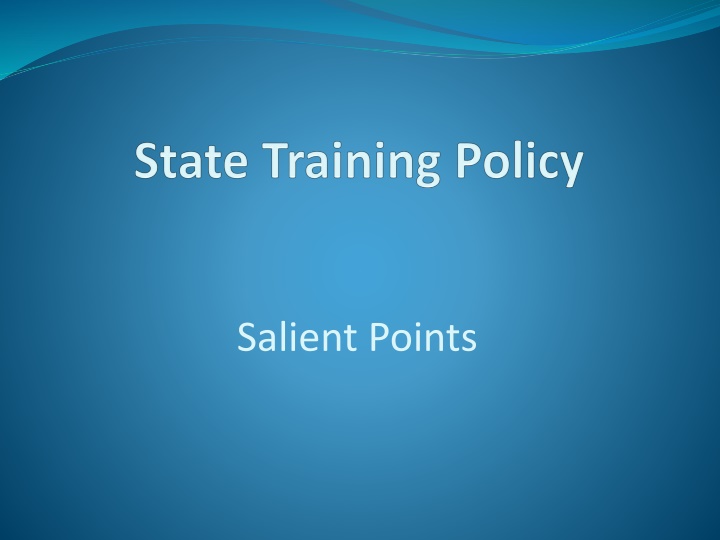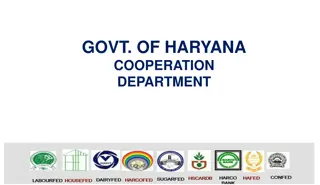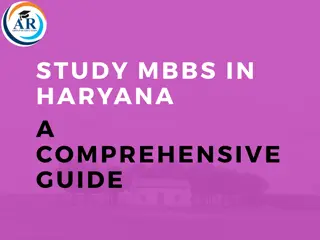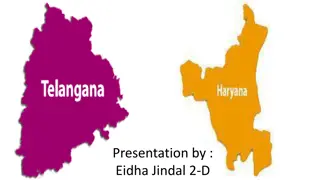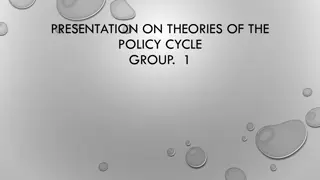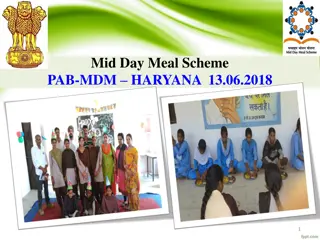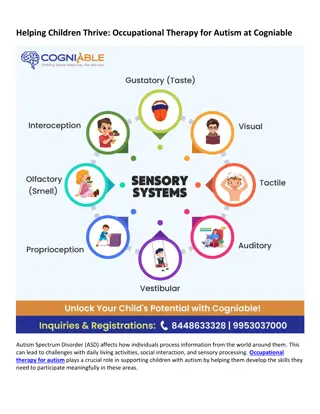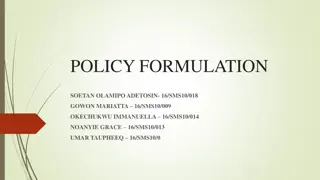Haryana State Training Policy 2020 Overview
The Haryana State Training Policy 2020 aims to provide training for all employees in the state system, ensuring ethical commitment, organizational responsibility, and skills development. The policy identifies competency gaps, targets all employees, and outlines training frequencies and durations for various categories. Emphasizing induction training, it sets specific durations for different officer groups, including IAS officers. Overall, the policy focuses on enhancing the quality of services and building a society sensitive to social issues.
Download Presentation

Please find below an Image/Link to download the presentation.
The content on the website is provided AS IS for your information and personal use only. It may not be sold, licensed, or shared on other websites without obtaining consent from the author.If you encounter any issues during the download, it is possible that the publisher has removed the file from their server.
You are allowed to download the files provided on this website for personal or commercial use, subject to the condition that they are used lawfully. All files are the property of their respective owners.
The content on the website is provided AS IS for your information and personal use only. It may not be sold, licensed, or shared on other websites without obtaining consent from the author.
E N D
Presentation Transcript
Haryana State Training Policy Haryana State Training Policy 2020 approved by the Council of Ministers on 6thJuly 2020. Mandate- Training forAll . Provides for necessary Infrastructure, Institutions and Personnel, Budget. Minimum one training for five days once in five years for each employee. Completing first cycle of training for all employees in three years.
Objectives of Policy To responsivecivil service. To ensure that all levels of civil services are given adequate attention. To inculcate ethical commitment to work and empathy towards vulnerable sections of society. To promote organizational responsibility, commitment and accountability. To impart knowledge, skills and attitude for effective performance. develop a professional, impartial, efficient & values, positive attitude,
Objectives of Policy To identify the gaps in the competency levels of individuals and organizations and effective tool for bridging the competency gaps for their currentand future roles. To establish a link between the career progression of employees and capacity building. To impart necessary skills to citizens as well as civil society organizations and to bring about attitudinal changes among them so that they can become partners in the development process of the State. To build a society sensitive towards social issues. use training as an
Training Target All Employees of Governmentof Haryana. State undertakings. State funded co-operative institutions. Elected representatives of Panchayati Raj Institutions & Local Bodies. Civil Society Organizations. Priority will begiven to training front line staff. Customer Orientation as well as quality of Service Delivery.
Training Frequency To equip civil servants with the competencies for their current or future jobs. Training will be imparted: At the time of entry into service. At the time of promotion. At appropriate intervals in the course of their careers. Each employee at leastonce in fiveyears.
Induction Training Joint FC for HCS & Allied: Six Weeks + One. Haryana Civil Service officers: OneYear. Other Group A officers: Six months including on-the-job training. Group B officers: One to three months including on-the- job training. Group C officials: Fourweeks including on-the-job training. Group D officials: Fourweeks including on-the-job training. IAS officers allotted to Haryana - Practical training in Revenue along with theoretical Institutional Training- Six Weeks). training during
In-Service Training Suitable & adequate training before or after promotion including for those joining on deputation. Refresher Training to all Group A, B and C employees for a period of no less than fivedays once in every fiveyears. Need based trainings for individuals and organizations as and when they arise. A mix of conventional courses, distance education and e-learning.
In-Service Training Quarterly Training Programs on Ethics & Integrity, Soft Skills, Language & Etiquettes Management etc. along with Stress Spiritual/Yoga institutes be made partners in the training program for instilling ethics and positive attitude among the trainees.
Role of Departments Appoint a Training Coordinator. Those with employee strength of 500 or more to create a Training Cell. Classify all posts with clear job description and competencies required. Develop Cadre Training Plans (CTPs), based on the competencies required and training needs. Link the training and development of competencies of individuals to theircareer progression. Ensure that any non training interventions that need to accompany training interventions are also taken up suitably.
Role of Training Institutions Ensure their mandate. Undertake functional studies, conduct Departmental and professional examinations, hold workshops, prepare manuals, training materials & organize training. Facilitate domain specific trainers and provide stability of tenureand opportunities for faculty development. Put in place a rigorous system of evaluation of training programs and assessment of their impact on individuals performance over time; and staff, infrastructure and finances to perform
Role of Training Institutions Develop productivity norms for its training faculty. Assist the Departments in shifting to a competency based framework for training. Become model of excellence in the quality of the training.
Training Needs Analysis Administrative Department to undertake Training Need Analysis in general or on specific topic at its own level or through HIPA or STI or other agency with approval of the Nodal Department at any time. Training plan to be prepared by each department to address the gap between competency. To sponsor the employees for training to HIPA/STIs to acquire competencieson basis of TNA. existing and required
Funding Each Department/Organization shall provide adequate funding. Each Department/Organization to earmark 2.5 per cent of its salary budget for training. The infrastructure and manpower will be created suitably in the Government Training Institutions by the State Departments.
Role of HIPA Nodal agency for the implementation of this Policy. Issue appropriate guidelines to amplify and facilitate the implementation of this Policy. To conduct JFC & In-service-training Employees. Composition and implementation of technical training undertheoverall supervision of HIPA. Supporting conduct of Questionnaire for the Training Need Analysis for circulation to all the departments). of All TNA (Preparing of
Role of HIPA HIPA, being the apex body, will establish parameters and evaluate the training institutes of all Departments. To create a Common forum to Convene a meeting of all the Training Institutes of the state (such as HIRD/MRMI/SCERT/ PTS, DIETS & others). Conducting awareness WORKSHOP for the competency based Human Resource Management. SETTING UP OF Audio/Video wing with Studio in HIPA for developing online courses through channels etc. Documentation of thegood practices and innovations. Training of Peons in coordination with the IHM. broadcasting, you-tube
Key Features of the Policy Building competencies and skills at each level of Civil Services. Focus on professional knowledge and skills needed for betterperformance of individual and organization. Focus on Ethics, Moral values, Work-life Balance. Sensitization for professional, political environment in which work is done. Encourages foreign training and Training in the other states for better exposure of Best Practices and latest inputs. socio-economic and
Power & Procedure for the Amendment in the State Training Policy Change in duration of Induction & Mid Term trainings, giving responsibility regarding program/procedure/function - Competent Authority - CS to Government of Haryana. a specific training For changing any of the basic structure of the policy on recommendation of the State Training Council, approval of the Hon ble Chief Ministerwill be required.
State Training Policy Thank You
